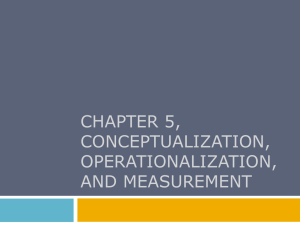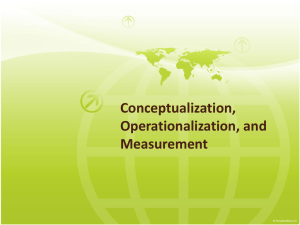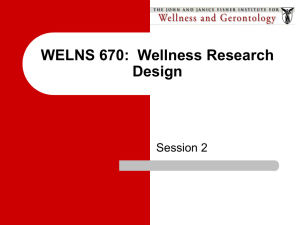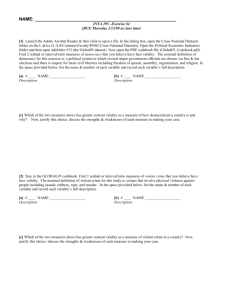Chapter 5-word
advertisement
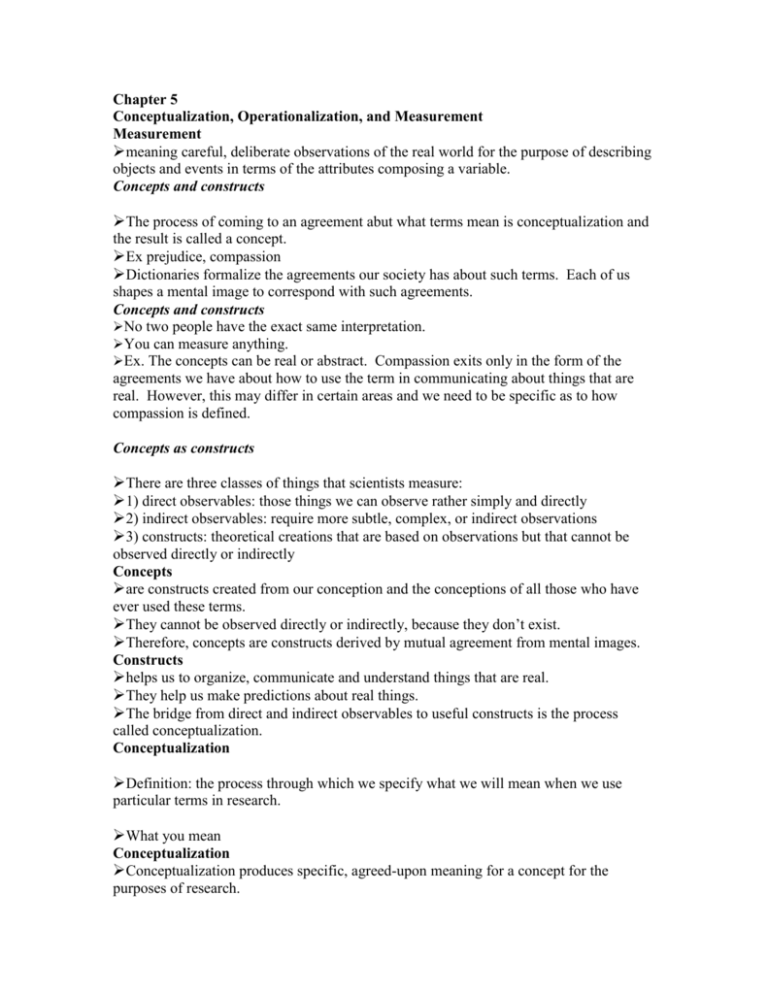
Chapter 5 Conceptualization, Operationalization, and Measurement Measurement meaning careful, deliberate observations of the real world for the purpose of describing objects and events in terms of the attributes composing a variable. Concepts and constructs The process of coming to an agreement abut what terms mean is conceptualization and the result is called a concept. Ex prejudice, compassion Dictionaries formalize the agreements our society has about such terms. Each of us shapes a mental image to correspond with such agreements. Concepts and constructs No two people have the exact same interpretation. You can measure anything. Ex. The concepts can be real or abstract. Compassion exits only in the form of the agreements we have about how to use the term in communicating about things that are real. However, this may differ in certain areas and we need to be specific as to how compassion is defined. Concepts as constructs There are three classes of things that scientists measure: 1) direct observables: those things we can observe rather simply and directly 2) indirect observables: require more subtle, complex, or indirect observations 3) constructs: theoretical creations that are based on observations but that cannot be observed directly or indirectly Concepts are constructs created from our conception and the conceptions of all those who have ever used these terms. They cannot be observed directly or indirectly, because they don’t exist. Therefore, concepts are constructs derived by mutual agreement from mental images. Constructs helps us to organize, communicate and understand things that are real. They help us make predictions about real things. The bridge from direct and indirect observables to useful constructs is the process called conceptualization. Conceptualization Definition: the process through which we specify what we will mean when we use particular terms in research. What you mean Conceptualization Conceptualization produces specific, agreed-upon meaning for a concept for the purposes of research. Process of specifying clearly exactly what you mean by a term Conceptualization This process of specifying exact meaning involves describing the indicators we’ll be using to measure our concept and the different aspects of the concept, called dimensions. Indicators An indicator is a sign of the presence or absence of the concept we are studying. Ex. We might agree that visiting a children’s hospital on a holiday is an indicator of compassion. Social researchers focus their attention on the meanings given to words and actions by the people under study. Dimensions Dimensionalizing means subdiving a concept into several specifiable aspects Each dimension of a concept must also be conceptually defined Example of dimensions Alienation: Powerlessness Meaninglessness Normlessness Isolation Self-estrangement Real, Nominal, and Operational Definitions The specification of concepts in scientific inquiry depends on nominal and operational definitions Nominal definition: one that is simply assigned to a term without any claim that the definition represents a real entity. These are arbitrary. Most nominal definitions represent some consensus, or convention, about how a particular term is to be used. Operational definition: specifies precisely how a concept will be measured – the operations it will perform. Conceptualization ↓ Nominal Definition ↓ Operational Definition ↓ Measurements in the Real World Definitions are more problematic for descriptive research than for explanatory research. Operationalization Choices Remembering: Conceptualization is the refinement and specification of abstract concepts, and operationalization is the development of specific research procedures (operations) that will result in empirical observations representing those concepts in the real world. Range of variation Must be clear about the range of the concept that will interest them in their research. Variations between the extremes: degree of precision is a consideration in operationalizing variable how fine will you make distinctions among the various possible attributes composing a given variable Whenever you are not sure how much detail to pursue in a measurement, get too much rather than too little. Defining variables and attributes: an attribute is a characteristic or quality of something variables are logical sets of attributes attributes should be exhaustive: for the variable to have any utility in research, we must be able to classify every observation in terms of one of the attributes composing the variable attributes composing a variable must be mutually exclusive every observation must be able to be classified in terms of one attribute Levels of Measurements Nominal measures: variables whose attributes have only the characteristics of exhaustiveness and mutual exclusiveness Ex. Gender, political parties nominal measures merely offer names or labels for characteristics Ordinal measures: variables with attribute we can logically rank-order Ex. SES, alienation, prejudice you can say one is more than the other Interval measures: the actual distance separating those attributes does have meaning the logical distance between attributes can be expressed in meaningful standard intervals Ratio measures: most of the social scientific variables that meet the min. requirements for interval measures also meet the requirements for ratio measures however, ratio measures are based on a true zero point Ex. Age, income Most of the time interval and ratio measures will be grouped together, and termed interval/ratio level of measurement. You must always consider the level of measurement in your research. You should anticipate drawing research conclusions appropriate to the levels of measurement used in your variables. Ratio measures are the highest level, descending through interval and ordinal to nominal, the lowest level of measurement. Nominal and ordinal are usually associated with qualitative research and interval and ratio with quantitative research. Criteria for Measurement Quality Precision measurements can be made with varying degrees of precision precision concerns the fineness of distinction made between attributes composing a variable general rule: precise measurements are superior to imprecise ones Reliability reliability is a matter of whether a particular technique, applied repeatedly to the same object, yields the same result each time Test-retest method to make the same measurement more than once, to the same group you should expect the same response both times Split-halt method as a general rule, it’s always good to make more than one measurement of any subtle or complex social concept, such as prejudice, alienation, or social class Using established measures use measures that have proven their reliability in previous research Reliability of research workers it is possible for measurement unreliability to be generated by research workers Validity refers to the extent to which an empirical measure adequately reflects the real meaning of the concept under consideration basically, does it measure what you want it to measure Face validity Measure appears, on the surface, to measure what the researcher intends to measure Criterion-related validity based on some external criterion Ex. Many occupations have qualifying exams. The validity of the exam is shown in its ability to predict future evaluations of the individuals’ job performances Construct validity based on the logical relationships among variables we can consider how the variable in question ought, theoretically, to relate to other variables Content validity refers to how much a measure covers the range of meanings included within the concept This is a trade off. In a quantitative study, one will get more reliability than validity and in a qualitative study validity will be more important than reliability.

